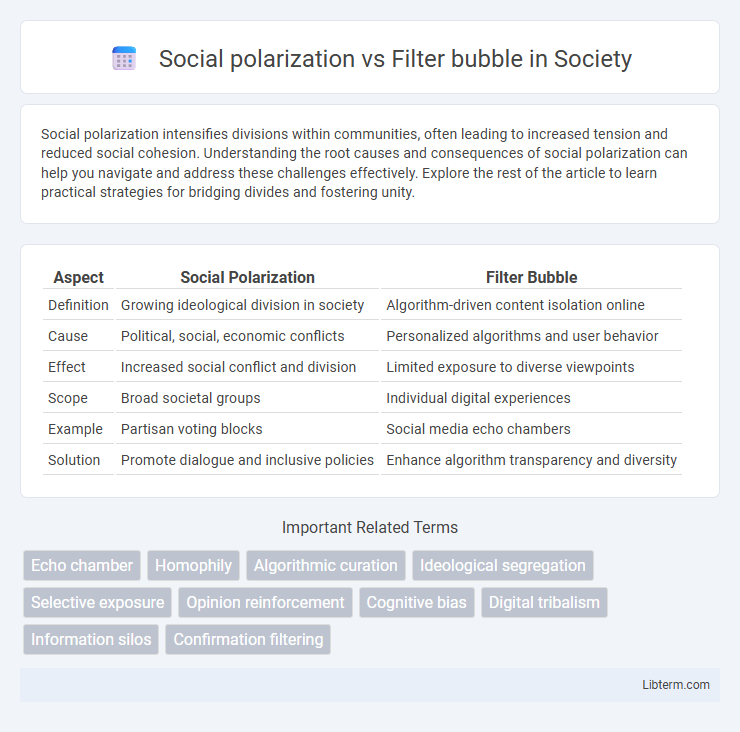Social polarization intensifies divisions within communities, often leading to increased tension and reduced social cohesion. Understanding the root causes and consequences of social polarization can help you navigate and address these challenges effectively. Explore the rest of the article to learn practical strategies for bridging divides and fostering unity.
Table of Comparison
| Aspect | Social Polarization | Filter Bubble |
|---|---|---|
| Definition | Growing ideological division in society | Algorithm-driven content isolation online |
| Cause | Political, social, economic conflicts | Personalized algorithms and user behavior |
| Effect | Increased social conflict and division | Limited exposure to diverse viewpoints |
| Scope | Broad societal groups | Individual digital experiences |
| Example | Partisan voting blocks | Social media echo chambers |
| Solution | Promote dialogue and inclusive policies | Enhance algorithm transparency and diversity |
Understanding Social Polarization
Social polarization refers to the growing division in society where groups adopt increasingly contrasting beliefs and values, often leading to social fragmentation and conflict. This phenomenon is amplified by filter bubbles, which are algorithm-driven online environments that expose users predominantly to information aligning with their existing views. Understanding social polarization requires analyzing how filter bubbles reinforce echo chambers, reducing exposure to diverse perspectives and intensifying ideological separation.
What is a Filter Bubble?
A filter bubble is a personalized online environment created by algorithms that selectively present information based on a user's past behavior, preferences, and interactions. This phenomenon limits exposure to diverse perspectives by isolating individuals within echo chambers, reinforcing existing beliefs and biases. Unlike broader social polarization, which involves societal divisions based on ideology or identity, filter bubbles specifically refer to digital content curation that narrows worldview access.
The Role of Algorithms in Content Curation
Algorithms in content curation significantly contribute to social polarization by selectively amplifying information that aligns with users' existing beliefs, creating digital echo chambers. These algorithms analyze user behavior data to personalize feeds, often reinforcing biases and limiting exposure to diverse perspectives. As a result, both filter bubbles and social polarization intensify, undermining pluralism and informed public discourse.
Key Differences: Social Polarization vs Filter Bubble
Social polarization refers to the growing ideological or societal divisions within a population, often exacerbated by external influences such as media or political rhetoric. Filter bubbles, in contrast, are personalized online environments where algorithms selectively expose users to information that reinforces their existing beliefs, limiting exposure to diverse perspectives. While social polarization manifests as a collective societal split, filter bubbles operate at an individual level by curating content that narrows cognitive diversity and amplifies echo chambers.
How Filter Bubbles Fuel Polarization
Filter bubbles intensify social polarization by restricting exposure to diverse perspectives, effectively isolating individuals within echo chambers that reinforce existing beliefs. Algorithms on platforms like Facebook and YouTube prioritize content aligned with users' preferences, deepening ideological divides and reducing cross-cutting dialogue. This digital segmentation amplifies confirmation bias, hindering mutual understanding and increasing societal fragmentation.
Impacts on Society and Democratic Discourse
Social polarization intensifies divisions within society by reinforcing in-group and out-group mentalities, leading to fragmented communities and heightened conflicts, which undermines social cohesion and democratic dialogue. Filter bubbles exacerbate this effect by limiting individuals' exposure to diverse viewpoints, creating echo chambers that distort their perception of reality and reduce critical engagement with opposing perspectives. Together, these phenomena threaten democratic discourse by fostering intolerance, misinformation, and mistrust, ultimately weakening the foundations of pluralistic societies.
The Psychology Behind Echo Chambers
Social polarization intensifies as individuals gravitate towards homogenous groups that reinforce their beliefs, creating distinct ideological divides. Filter bubbles, driven by algorithmic personalization, limit exposure to diverse perspectives, amplifying confirmation bias and groupthink. The psychology behind echo chambers reveals how cognitive dissonance and motivated reasoning entrench attitudes, reducing openness to opposing views and deepening social fragmentation.
Breaking the Cycle: Solutions and Strategies
Breaking the cycle of social polarization and filter bubbles requires implementing diverse information exposure strategies, such as promoting cross-ideological dialogue on social media platforms and algorithmic transparency by tech companies. Encouraging media literacy education empowers users to critically analyze content and reduce susceptibility to echo chambers. Collaborative efforts between policymakers, educators, and technology developers are essential to create inclusive digital environments that bridge divides and foster mutual understanding.
Case Studies: Social Networks and Polarization
Case studies on social networks reveal that social polarization intensifies when filter bubbles limit exposure to diverse viewpoints, reinforcing homogeneous group ideologies. Research on platforms like Facebook and Twitter shows algorithmic curation amplifies echo chambers, increasing ideological segregation and reducing cross-cutting interactions. Analysis of polarization dynamics emphasizes the role of tailored content streams in deepening societal divides and hindering constructive dialogue.
Future Challenges in Combating Digital Division
Social polarization intensifies as filter bubbles limit exposure to diverse viewpoints, deepening ideological divides within online communities. Future challenges in combating digital division include developing advanced algorithms that promote content diversity while respecting user preferences and privacy. Enhancing digital literacy and fostering inclusive platforms are critical to mitigating polarization and ensuring equitable access to information.
Social polarization Infographic

 libterm.com
libterm.com